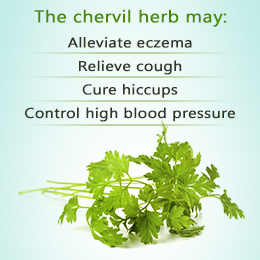High in nutrition, the chervil herb acts as a blood purifier and a diuretic, which can detoxify as well as nourish the body. Here's more about the uses and health benefits of the chervil herb.

Did You Know?
Augmenting your everyday salads with a tablespoon of fresh chervil leaves is one the best ways to reap the health benefits of the chervil herb.
The chervil herb, also referred to as french parsley is a folk medicine that has been around for centuries to treat various ailments. This annual herb, that attains a height of 40 to 70 cm, has tripinnate leaves and small white flowers that are commonly used for medicinal purposes. Be it the poultice, infusion, or the tea made from chervil, its leaves are important in making these herbal preparations. The herb is also used for flavoring purposes in a variety of food preparations.
The following are the various health benefits that this herb has to offer.
Alleviates Skin Problems
Its rich history of medicinal use also extends to relieving skin problems. Chervil can work wonders to soothe discomfort associated with acne and eczema. Due to its ability to soothe the skin, it is often added in lotions and cleansers. Applying a cotton ball soaked in strong chervil tea can also help minimize distress associated with insect bites and eczema. The moisturizing property of chervil may work to facilitate the healing of insect bites and stings.
Relieves Cough
Chervil, known for its strong expectorant qualities, may help liquefy the trapped mucus and facilitate its expulsion from the respiratory tract. This property is helpful in treating a productive or wet cough, as it eases chest congestion. Productive cough commonly associated with respiratory infections such as bronchitis may respond to the use of chervil.
Stops Hiccups
Looking for an easy home remedy to relieve hiccups? Chewing fresh leaves of chervil may cure hiccups. Historically, during the Middle Ages, taking a teaspoon of chopped chervil was thought to be effective in getting rid of hiccups. This can also be combated by consuming chervil leaves dipped in vinegar.
Good Source of Nutrition
Chervil is celebrated for its nutritional qualities for centuries. It contains a great deal of carotene, vitamin C, iron, manganese, and magnesium. So, its addition can certainly enhance the nutritional profile of one's favorite dishes. In fact, chervil pairs well with several dishes, particularly those that contain chicken, eggs, and fish.
Controls Blood Pressure
The chervil herb that is used to treat blood circulation problems may work in maintaining healthy blood pressure. Its traditional usage has been described in the treatment of high blood pressure. As a folk medicine, drinking chervil tea was considered beneficial in lowering high blood pressure.
Effective Common Cold Remedy
As the herb displays anti-inflammatory properties, it can also be used to treat common cold as well as seasonal flu that causes inflammation of the nasal passages.
Strengthens the Immune System
A herbal infusion containing chervil can also act as an immune-building tonic. In order to make this tonic that boosts immunity, add ½ teaspoon of chopped chervil, vervain, and red clover in a cup of boiling water. Allow it to steep for 5 to 10 minutes. The tonic thus prepared after removing the herbs can be taken once in the morning and evening to ward off an illness.
Removes Impurities
Drinking fresh chervil tea acts as a detoxifying agent and assists in removing the impurities from the blood. When taken as a tisane, it is said to cleanse the liver. As a blood purifier, it may assist in improving skin health. Its diuretic property is also beneficial to facilitate the elimination of toxins through urine. As a diuretic, it can also assist to get rid of kidney and bladder stones.
Relieves Gout
Chervil is said to display potent anti-inflammatory activity, and can help treat inflammatory conditions of the joints. Applying a poultice made from its leaves or taking an infusion of chervil may work in treating gout and rheumatism.
Promotes Digestion
Just 100 g of dried chervil provides a significant amount of dietary fiber (around 11.3 g), which assists in keeping the digestive system healthy. Adequate fiber in the diet is crucial to maintain normal bowel movement, in turn improving digestion. So, addition of chervil to everyday meals can certainly contribute to enhance digestive function.
Usage
Applying chervil juice on the affected part of the body is one of the best ways to treat skin problems. It is made by blanching chervil and then combining it with ice water in a blender. Ingesting a specified amount of chervil juice would also help recover from skin problems.
Cooking with Chervil
The leaves of the chervil herb tend to leave a bitter taste to a dish if they are added at the start of the cooking process. Hence, it is advised to stir the dish with chervil leaves or chopped chervil just before serving. The herb can also make a great garnish, and can be added in pastas, stews, and soups. Also, when it comes to salad dressings that enhance flavor, one simply cannot forget fresh chervil leaves.
Caution
There are no sufficient clinical studies that support the efficacy of chervil in treating various medical conditions. The herb, that is viewed as a folk medicine, has very limited scientific backing, and as such, should not be used without consulting a qualified medical practitioner.
Disclaimer: The information provided in this article is solely for educating the reader. It is not intended to be a substitute for the advice of a medical expert.






